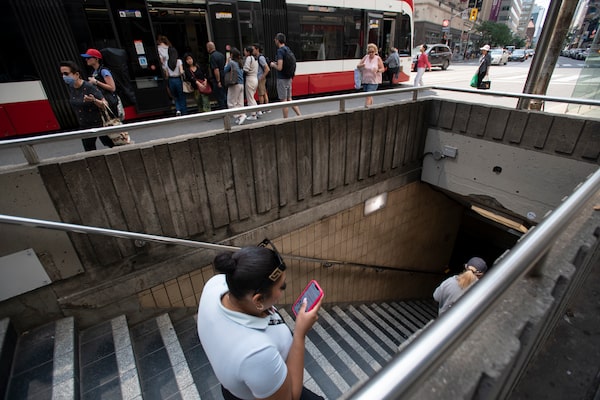
A TTC user checking their phone while heading down to the subway station at College St. is photographed on Aug. 21.Fred Lum/The Globe and Mail
David Sax’s most recent book is The Future Is Analog: How to Create a More Human World.
Descending into an underground parking garage last week, Taylor Swift’s voice began freezing mid-lyric, as my phone lost contact with the Rogers tower. Karma jumped in and out in a choppy staccato from the car’s speakers, before going silent on P2.
“What the hell?” my daughter demanded. “That’s my song!”
“We’re underground,” I explained. “The internet doesn’t reach here.”
“Ugh,” she said, slumping into her seat. “That sucks.”
If you also mourn the momentary loss of Spotify underground, this is your week to breathe a sigh of relief. As of Oct. 3, cellular phone service is supposed to be available on much of the Toronto Transit Commission’s subway system for customers of all networks, bringing us (belatedly, of course) in line with subway systems all over the world – and erasing one of the last unconnected spaces in the city.
This transformation has been relatively swift. Research in Motion brought its first BlackBerry smartphone to the Canadian market in 2002, and by 2007, when the iPhone came out, holding the internet in our hands in every possible space in the city (parks, playgrounds, restaurants, sidewalks, coffee shops, in cars, on buses and streetcars, on toilets, in waiting rooms) became so instantaneously normal, we forgot what life was like before.
The spaces where phones failed to connect quickly diminished to a handful of underground pockets. In their disconnected state, these spots (parking garages, the subway, random corners of basements) increasingly became inconvenient outliers …annoying laggards where the world suddenly reverted to the 20th century, and there was nothing to do but stare at the walls. Soon, the very idea of unreachable urban areas was an affront to our society. To live in the urban world meant to be connected at all times, and a virtuous goal behind every single telecom ad, where your signal now reaches to your remote campsite, where you can stream Succession with 5G under the stars! Torontonians spoke of a lack of signal on the subway as a human-rights issue. Other cities had this. Why didn’t we?
Despite being an advocate for analog’s virtues, and someone who can easily unplug and even leave my phone at home, I’m as tethered to its signal as anyone else. As I waited for 56 minutes in the return section of Ikea the other week, I barely lifted my eyes from the screen. Give me a second of boredom, a break in movement, a line or a wait or a moment of silence, and I’ll be there, refreshing the news, firing off texts, juggling between pixels to eat up the emptiness. I’m on my phone on the sidewalk, at red lights and on the streetcar. I too have sat on the subway in the past few months, tapping my foot with impatience, as I stare at the bars on my screen, then the ads above me, then the frustrated faces of fellow riders, waiting to be hooked back in. What’s the holdup? Let’s go!
Phone-free spaces are wonderful and necessary, but clawing disconnectivity back is technologically and socially tricky. We have to ask, plead, incentivize and, if necessary, to confiscate, enforce and block. Schools, theatres, restaurants, coffee shops, hospitals and other spaces that want to carve out a tiny slice of disconnectivity for excellent reasons (safety, education, social enjoyment) have resorted to public-service messages, rules, and even tricks like the Yondr system, which temporarily locks phones in a signal-proof bag. Stuffing the genie back into the bottle is a heck of a lot harder when your society becomes reliant on genies.
There’s definitely something about urban life we lose when we connect every inch of a city. A few weeks back, I ended up on a jammed streetcar with my son, crossing downtown Toronto. Pressed in against a window, holding onto his frail little body with one hand and a few inches of pole with the other, there was nothing to do but look. We looked out the window, where he asked about signs and construction sites and the random beauty and horrors of urban excitement and decay that passed by. We saw street drummers, open drug markets, police horses and an evangelical Christian parade. We looked at the people and outfits jammed in around us, picking up snippets of conversation in a handful of languages and intonations, and even exchanged glances and smiles with these fellow sardines in our tin can.
We weren’t just passing through the city, we were part of it, fully participating in urban life for half an hour. It was uncomfortable and slow and frustrating, but also kind of magical. The kind of everyday experience he will remember forever. Active. Engaged. Connected to the city in a way that four cellphone bars couldn’t possibly measure, and a digital signal would do nothing to amplify.